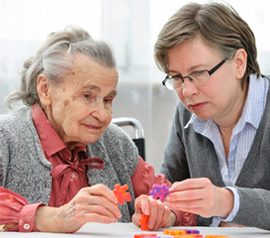Advances in orthopedic rehab mean quicker recovery period
Think you’re going to stay a week in the hospital after a joint replacement?
Those days are gone. Instead, they have been replaced with advancements in care that have transformed the experience both in the hospital and at home. With a new focus on “rapid recovery protocols,” doctors treat people recovering from orthopedic surgery as “well” patients who should get back on their feet as soon as possible with the help of a few innovations in hospital care, surgery, and rehabilitation.
Hospital Care
“Rapid recovery” is the main goal of an orthopedic surgical team. This begins with the procedure itself. Doctors have found it no longer necessary to perform a surgery that requires immobility during recovery followed by a lengthy hospital stay.
“In past eras, and still in some regions of the world, it was thought that a slow convalescence with an extended acute hospital stay of several weeks was the best way for patients to recover and achieve a good outcome after total joint replacement” writes Adolph Lombardi Jr., MD, Keith R. Berend, MD, and Joanne Adams, BFA, in the article, A Rapid Recovery Program: Early Home and Pain Free. “However, we have learned that by changing our team mindset and streamlining our protocols, patients can recover faster, safer, and with better outcomes.
”Today’s hospital stays are now usually no more than 2-3 days.
Less Invasive Surgery
The philosophy behind rapid recovery protocol is that the faster you get up and moving, the faster you will recover.
To help accomplish that goal, today’s orthopedic surgeons often perform a less-invasive procedure, where the joint itself is resurfaced rather than removed completely. Less cutting means a quicker healing time and a speedier recovery.
It is not uncommon for patients to walk around immediately following joint replacement surgery.
Rehabilitation
Today’s orthopedic teams encourage patients to immediately participate in skilled nursing or outpatient rehabilitation programs.
“Rehabilitation in general is transferring a mindset from a sick-patient model to a well-patient model,” explained Dr. Adam Bergeson, an orthopedic surgeon and board member of Orchard Park Rehab. “We don’t treat patients who are coming in for a total joint replacement like they’re sick or have an illness. Instead, we view them as patients who simply had a procedure done. Their body systems are functioning well, and they can rehabilitate and get up and walk the same day.”
An exciting addition to the rehabilitation program is wearable technology. With devices such as FitBit and WearMD , patients are able to track their vital signs with an app. Doctors and physical therapists use this information to track the progress of their patients and better gauge the effectiveness of the patient’s rehabilitation schedule.
With access to this technology, patients can return home from surgery and begin their rehabilitation program with confidence, comfort, and the support of friends and family.
This isn’t your grandma’s joint replacement surgery. Today’s patients experience advanced technologies in surgical procedures, streamlined follow-up care, and innovative rehabilitation technology that accelerates your progress and places you well on the road to recovery.
Amy Osmond Cook, Ph.D., in her bimonthly columns, uncovers the many factors that help a person stay healthy, live longer and have a better quality of life.
